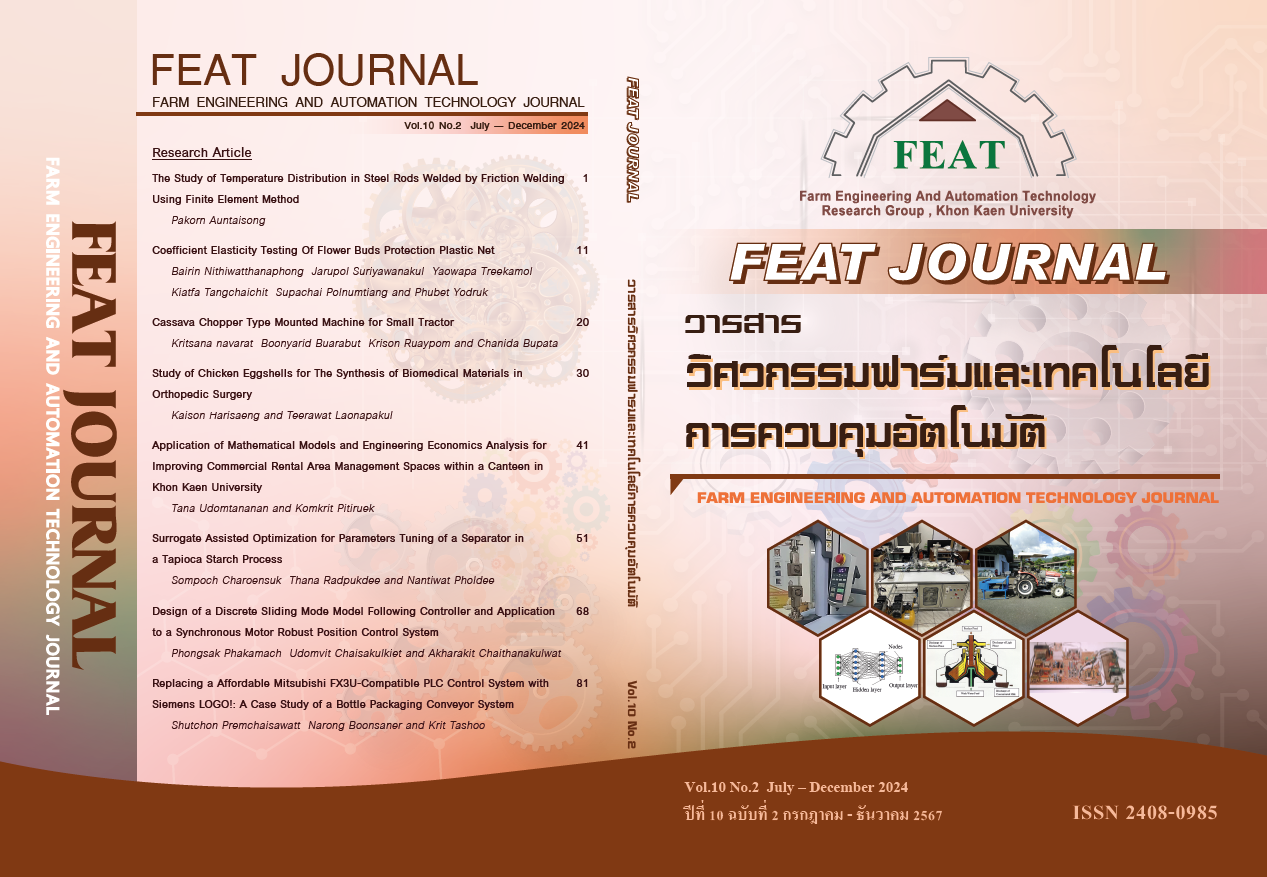Surrogate assisted optimization for parameters tuning of a separator in a tapioca starch process
Main Article Content
บทคัดย่อ
This study employs a single-objective differential evolution optimizer for surrogate-assisted optimization. A separator plant is modeled using five surrogate approaches for process optimization. The optimization objective is defined as minimizing starch loss relative to the Baume output of starch milk, while adhering to the lower and upper bounds of design parameters, including pulp input, Baume input, and regulated valve flow control. These bounds also support the plant controller's original design parameters. The optimal parameters were implemented and their real and numerical performances compared to validate the proposed method. The results demonstrate that the suitable surrogate model for the separator plant can be identified and that the optimal characteristics can be achieved, providing practical benefits to the process.
Article Details

This work is licensed under a Creative Commons Attribution-NonCommercial-NoDerivatives 4.0 International License.
วารสารวิศวกรรมฟาร์มและเทคโนโลยีควบคุมอัตโนมัติ (FEAT Journal) มีกําหนดออกเป็นราย 6 เดือน คือ มกราคม - มิถุนายน และกรกฎาคม - ธันวาคม ของทุกปี จัดพิมพ์โดยกลุ่มวิจัยวิศวกรรมฟาร์มและเทคโนโลยีควบคุมอัตโนมัติ คณะวิศวกรรมศาสตร์มหาวิทยาลัยขอนแก่น เพื่อเป็นการส่งเสริมและเผยแพร่ความรู้ ผลงานทางวิชาการ งานวิจัยทางด้านวิศวกรรมศาสตร์และเทคโนโลยีพร้อมทั้งยังจัดส่ง เผยแพร่ตามสถาบันการศึกษาต่างๆ ในประเทศด้วย บทความที่ตีพิมพ์ลงในวารสาร FEAT ทุกบทความนั้นจะต้องผ่านความเห็นชอบจากผู้ทรงคุณวุฒิในสาขาที่เกี่ยวข้องและสงวนสิทธิ์ ตาม พ.ร.บ. ลิขสิทธิ์ พ.ศ. 2535
References
Alexander I, Forrester J, András S, Andy J. Keane. Engineering Design via Surrogate Modelling: A Practical Guide, University of Southampton: UK: 2008. John Wiley & Sons Ltd.
Ali W, Khan M. S, Qyyum, M. A, Lee M. Surrogate-assisted modeling and optimization of a natural-gas liquefaction plant. Computers and Chemical Engineering 2018; 118 : 132-142.
Bagheri S, Reinicke U, Anders D, Konen W. Surrogate-assisted optimization for augmentation of finite element techniques. Journal of Computational Science 2021; 54: 101427.
Chen X, Wu K, Bai A, Masuku C. M, Niederberger J, Liporace, F. S, et al. Real-time refinery optimization with reduced-order fluidized catalytic cracker model and surrogate-based trust region filter method. Computers and Chemical Engineering 2021; 153: 107455.
Franzoi R. E, Kelly J. D, Menezes B. C, Swartz C. L. E. An adaptive sampling surrogate model building framework for the optimization of reaction systems. Computers and Chemical Engineering 2021; 152: 107371.
Hu A, Liao H, Guan W, Dong J, Qian X. Support vector machine model based on OTSU segmentation algorithm in diagnosing bronchiectasis with chronic airway infections. J Radiat Res Appl Sci 2023; 16: 100500. https://doi.org/10.1016/j.jrras.2022.100500.
Rojas-López A. G, Villarreal-Cervantes M. G, Rodríguez-Molina A. Surrogate indirect adaptive controller tuning based on polynomial response surface method and bioinspired optimization: Application to the brushless direct current motor controller. Expert Systems with Applications 2024; 245: 123070.
Stavros P. Adam, Stamatios-Aggelos N. Alexandropoulos, Panos M. Pardalos, and Michael N. Vrahatis (2019). No Free Lunch Theorem: A Review. Research Gate DOI: 10.1007/978-3-030-12767-1_5.
Sujin Bureerat. Mechanical System Engineering Optimization 1-2. Khon Kaen Univercity; 2013.
Wencheng J, Trevor A. A, Christine D, Ghanashyam N, Nicolas S, Travis L. M, et al. Machine-learning-assisted high-temperature reservoir thermal energy storage optimization, Renewable Energy 197 (2022) :384–397.
Ong Y. S, Zhou Z, Lim D. Curse and blessing of uncertainty in evolutionary algorithm using approximation. In 2006 IEEE international conference on evolutionary computation; 2006 July. IEEE; pp. 2928-2935.

